|
Network of Excellence |
CARiMan |
The Internet Portal for Computer Aided Risk Management |
ISIK
Dr.
Birep Aygün
M.Sc. Biotechnology, PhD Molecular Biology
BMRG Co-ordinator for EU FP6
External Alliances Co-ordinator
F.M.V Iþýk University
Büyükdere caddesi 34398 Maslak
Istanbul
Turkey
Tel: +90-212-2862960 ext 1911
Tel: +90212 2862960, ext: 1406
Fax:
+90212 2862970
ISIK University which is established in 1996 is one of the scientifically most productive and creditable private universities in Turkey.
E-Mail: bmrg@isikun.edu.tr , yarman@isikun.edu.tr , baygun@isikun.edu.tr
The
BioSignal Modeling Research Group (BMRG) is an interdisciplinary research team.
We are particularly interested in, and have developed various tools for
compression, feature extraction, modelling and filtering of biomedical signals
like ElectroCardioGram-ECG, ElectroEncephaloGram-EEG and ElectroMyoGram-EMGs.
Besides, we have major competence in speech processing (speech signal modelling,
word spotting isolated word recognition speaker identification). Our group has
devised a novel modelling method for biological signals based on the generation
of the so called the "Predefined-Personalised Functional Bases or
Banks-PPFB". The PPFB consist of the two major functional banks,
namely the "Envelope Functions Bank-EFB" and the "Signature
Functions Bank-SFB". The measured data are modelled as the multiplication
of the two appropriate functions, which are retrieved within a constant from the
above mentioned banks respectively. We are also dealing with storage and
transmission (coded-signal transfer) of such (raw and processed) data and
utilization of processed information for diagnostic purposes. We are keen in
composing a joint database to improve significance of modelled functions and
achieve wider standardization. Such databases would prove efficient tools in
early diagnosis of certain diseases. We are interested in RF communication and
GSM/interphase communication (in collaboration with our digital signal
processing group and microwave group). We are planning to expand our work to all
fields of medical telemetry.
Subject Index: Biotechnology; Coordination, Cooperation; Education, Training; Electronics, Microelectronics; Information Processing, Information Systems; Innovation, Technology Transfer; Life Sciences; Medicine, Health; Mathematics, Statistics; Scientific Research; Telecommunications
3.2
Contribution to CARiMan
B.4.1
Integrating Activities.
He:
Application of CARiManS for health monitoring in risk situations.
GR:
Medical health risk management using genetic research and high technology.
RE:
Risk modelling of Renewable Energy Sources.
Na:
CARiMan in nuclear Accidents.
Ac:
Monitoring of Agricultural Crop Diseases and Pest Risks.
B.4.2
Programme for jointly executed research activities.
KM:
Knowledge Management and DataBase System.
PD:
Portable devices, signal conditioning and conversion
SP:
Signal processing, Classification, Recognition and Evaluation
B.4.3
Activities to spread excellence
D1:
Exchange of post-doc researchers, students, and experts.
D2:
Conferences, meetings and workshops.
D3:
Dissemination&Exploitation
D4:
Publications
D5:
Advanced Training System for Emergency Management
CV
of Prof. Dr. B. Siddik Yarman
B. S. Yarman received B.Sc. in Electrical Engineering (EE), Istanbul Technical University (I.T.U.), Istanbul, Turkey, February 1974; M.E.E.E in Electro-Math Stevens Institute of Technology (S.I.T.) Hoboken, NJ., June 1977, Ph.D. in EE-Math Cornell University, Ithaca, NY, January 1982. Member of the Technical Staff, Microwave Technology Centre, RCA David Sarnoff Research Center, Princeton, NJ (1982-1984). Associate Professor, Anadolu University, Eskisehir, Turkey, Middle East Technical University, Ankara, Turkey (1985-1987). Visiting Professor and Fellow of Alexander Von Humboldt, Ruhr University, Bochum, Germany (1987-1994). Founding Technical Director and Vice President, STFA Defense Electronic Corp. Istanbul, Turkey (1986-1996), Full Professor, Chair of Div. of Electronics, Chair of Defense Electronics, Director of Tech. Science School, Istanbul University (1990-1996). Founding President, ISIK University, Istanbul, Turkey (1996-2003). Chief Technical Consultant in Charge of Security Affairs to the Prime ministry Office of Turkey (1996-2000). Young Turkish Scientist Award, National Research Council of Turkey (NRCT) (1986), Technology Award of Husamettin Tugac Foundation of NRCT (1987), International Man of Year in Science and Technology, Cambridge Biography Center of U.K. (1998). Member Academy of Science of New York (1994), Senior Member of IEEE (Since 1994). Four U.S. patents (1985-1986). More than 100 Technical papers, Technical Reports in the field of Matching Networks, Microwave Amplifiers, Mathematical Modeling, Speech and Biomedical Signal Processing (since 1982).
CV
of Assoc. Prof. Semahat Demir
|
Istanbul
Technical University, Istanbul, Turkey |
B.S. |
1984-1988 |
Electr.
& Telecom. Eng. |
|
Rice
University, Houston, TX |
M.S. |
1989-1992 |
Electr.
& Computer Eng. |
|
Rice
University, Houston, TX |
Ph.D. |
1992-1995 |
Electr.
& Computer Eng. |
|
Bogazici
University, Istanbul, Turkey |
M.S. |
1989
& 1996 |
Biomedical
Engineering |
|
Johns
Hopkins University, Baltimore, MD |
Postdoctoral |
1995-1996 |
Biomedical
Engineering |
Keywords: Computational bioengineering;
integrating research, education and training, and emphasizing mathematical
modeling and
computer simulations in both cardiac electrophysiology and neuroscience.
A
major thrust in her research program is the development of computational models
and software of cellular bioelectric activity for different computer platforms
including applications for internet and parallel high performance computing.
Computational
Cardiac Electrophysiology and Neuroscience: Dr. Demir’s research focuses on computational modeling of bioelectric
activity at cellular level for cardiac cells (pacemaker, atrial and ventricular
cells) and neurons (bursting and silent interneurons. Dr. Demir’s current
research collaborations within the Univ of Tennessee are with the scientists at
the Department of Physiology & Biophysics and the Neuroscience Center, and
outside with the Departments of Physiology & Biophysics at Univ of Calgary,
Texas Tech Univ, Univ of Queens and Univ of Montreal and Univ of Auckland.
Integration
of Computational Electrophysiology and Molecular Biology Data in the Field of
Bioinformatics:
It is a very exciting time in the next 5-10 years to bridge the computational
electrophysiology function data and the molecular data in the field of
bioinformatics
Utilization
of Experimental Data in Computational Model Development:
Since Dr. Demir uses experimental data from different sources (i.e. from her
collaborators and from published literature) and from fundamentally different
types of investigations, (1) from conventional electrophysiological studies on
ion channels and (2) from gene expression data for the putative molecular
correlates for the ion channels, in developing computational models, she is very
careful while pooling and normalizing the data with respect to different
experimental conditions.
Development
of Innovative Research Collaboration and Training Tools & Software:
Dr. Demir has developed and used some innovative research collaboration and
training tools by integrating her research and education. She is interested in
developing more of these tools for her future research projects and courses. Her
current research collaboration and training tools and resources are:
·
Interactive JAVA
Applications over the Internet (iCell: Interactive Cell Modeling Resource &
Computational Library of Cell Models, http://ssd1.bme.memphis.edu/icell/)
·
Interactive GUI-based
Simulations (Applications of Cell Models)
· Intranet Applications for Biological Data Analysis : Operating System Independent Software Development for Patient Record
DR.
DEMIR’S RESEARCH EXPERIENCE IN INDUSTRY
Dr.
Demir has research experience in industry in Germany, and Turkey. She developed
and designed a voltage stabilizer model for mobile x-ray devices at Unternehmens Bereich Medizinische Technik Siemens AG, in Erlangen
(Germany), where she worked as an intern for 3 months in 1988.
During her other internship at Siemens AG
(Siemens AG Geraetewerk, Karlsruhe, Germany), she developed FORTRAN based
software for process control systems in 1986. Also, the Dr. Demir had clinical
research experience with medical lasers and their applications in internal
medicine, neurosurgery and ophthalmology while
she was the technical manager and medical laser engineer (1988-1989) at
the representative of Messerschmidt Bolkow
Blohm (MBB) Medizintechnik and Rodenstock
of Munich (Germany) in Turkey.
CV
of Dr. Umit Guz
Umit Guz finished Istanbul Pertevniyal High School in 1988 and Yildiz Technical University (Y.T.U.), Department of Computer Programming, Istanbul, Turkey in 1990. He received the B.Sc. degree with high honors from Istanbul University, Engineering Faculty, Department of Electronics Engineering, Istanbul, Turkey in 1994. He received M.Sc. and Ph.D. degrees in Electronics Engineering from the Istanbul University, Institute of Science, Istanbul, Turkey in 1997 and 2002 respectively. From 1995 to 1998 he was a research and teaching assistant at Istanbul University, Engineering Faculty, Department of Electronics Engineering, Istanbul, Turkey. He has been research associate and lecturer at ISIK University, Engineering Faculty, Department of Electronics Engineering, Istanbul, Turkey since 1998. His research is in signal processing, in particular concerning the modeling, representation, and compression of speech and biomedical signals (ElectroEncepHalogram, ElectroCardioGram, ElectroMygram), feature extraction, speech recognition, speaker identification, signal processing and applications, neuroscience and telemedicine.
CV
of Hakan Gurkan (Ph.D. Student)
Hakan Gurkan received the B.Sc. and M.Sc. degrees in Electronics and Communication Engineering from the Istanbul Technical University, Istanbul, Turkey in 1994 and 1998 respectively. He has been a research and teaching assistant in ISIK University, Engineering Faculty, Department of Electronics Engineering since 1998. His research is in signal processing, in particular concerning the modeling, representation and compression of biomedical and speech signals.
CV
of Dr. Ebru Gursu Cimen
She
received the B.Sc. degree in Electronics Engineering from the Department
of Electrical and Electronics Engineering of the Faculty of
Engineering and Architecture of the Gazi University in
1992 and M.Sc. and Ph.D. degrees from Istanbul University in 1995 and 2000
respectively. From 1993-1997 she was a research assistant with the Istanbul
University. Since 1997 she is with ISIK University as an associate researcher
and lecturer at electronic engineering department. Her current interests are
multivariable circuit design, computer aided circuit design, design of microwave
filters, broadband matching networks, amplifiers and numerical methods.
CV
of Dr. Ali Kilinc
Ali
Kılınc¸ received the B.Sc. and M.Sc. degrees in Electronic
Engineering from the Uludag University, Bursa, Turkey in 1986 and 1989
respectively. He completed his Ph.D. in the area of impedance modeling at
Istanbul University, Turkey in 1995. Until 1998 he was teaching as a lecturer in
Istanbul University. From 1998 to 2001 he was working as hardware design
engineer at Nortel Networks-Netas¸ Turkey. Since 2001, he is working as
research associate/lecturer at ISIK University on data and circuit modeling.
CV
of Haluk Yuzucu (Ph.D. Student)
Haluk
Yüzücü was born in Sapanca, in 1975. He graduated High School from İzmit
Merkez Lisesi in Kocaeli. He graduated Near East University Computer Engineering
Department in 1998 in Lefkosa, Cyprus. He started the work life in Işık
University Computer Center in 1998. He graduated M.Sc. Degree in Işık
University Institute of Arts and Science, Department of Information Technologies
in 2003. He completed master thesis work which name is SMS Distribution and
Information Query Service with Prof. B. Sıddık Yarman. He worked about
GSM Technologies, Internet Technologies, Web Based Applications, Communication
System and Wireless Technologies. He developed 2 projects about GSM Technologies
and Internet Technologies in Işık University and he presented in CEBIT
2003 in Hannover. Germany.
CV
of Coskun Tekes (Ph.D. Student)
He
was graduated from the faculty of Electrical and Electronics of Istanbul
Technical University in 1998.He was working as a design engineer in Teknobil
Inc. from 1999-2002. He worked on the hardware and firmwaredesign of some
projects like, vehicle tracking systemsover GPS, GSM-based prepaid metering
systems, telematic control systems. He got his master ofscience degree
from the Electronics department of ISIK University in 2002. He realized and
implemented a Fixed Cellular Terminal project as a master thesis. Since 2002 he
is continueing his Ph.D. program in ISIK University.
CV
of Alper Sisman (Ph.D. Student)
He graduated from Faculty of Electrical&Electronics Engineering of İstanbul Technical University in 1998. He got his Master of Science degree from ISIK University in 2002. He started to work for Inter Electronics Inc. at military Project division as DSP engineer. The Matlab simulations are prepared but he quit from Inter electronic inc. After that he started to work for Teknobil Inc. in 1999. He developed several microprocessor based Projects for Teknobil inc. In 2003 he continue his career in Mobiarts Communication Systems as Project based shareholder. Also he is a research assistant in Isık University since November 2003.
Research Areas
1. Area of Speech Processing and Applications
Transmission
and storage of speech signals are widespread in modern communications systems.
Reducing the amount of information required to faithfully reproduce a speech
signal can significantly increase the capacity of digital speech transmission
and storage system. The field of speech representation or compression is
dedicated to finding new, more efficient ways to reduce transmission bandwidth
or storage area while maintaining high quality of hearing. Feature extraction,
classification, compression, coding and reconstruction techniques have been
popular subjects of signal processing. Over the last ten years, a number of new
tools, especially for signal representation and compression have been proposed.
Most of these methods utilize time or frequency domain properties of the signals.
It should also be mentioned that transform domain techniques such as Discrete
Cosine Transform (DCT), Karhunen Loeve Decomposition (KLD) provide reasonable
compression rate, feature extraction and reconstruction in speech processing. In
addition to speech compression and speech coding, other applications of the
speech processing are speaker identification, speech recognition and speech
synthesis. These are expected to play important roles in advanced multi-media
systems with user-friendly human-machine interfaces. Especially, in the area of
speech processing, it is crucial to obtain an ultimate robust speech recognition
system. This system must have the capability of changing its own parameters
according to voice variation due to the factors of individuality, the physical
and psychological condition of the speaker, additive background noise, and
speaking styles and so on.
Our
research group focused on especially finding new and efficient approaches for
modeling, reconstruction and recognition of speech signals, word spotting, Text
to Speech (TTS) and Speech to Text (STT) applications. Our research works can
also be extended to obtain the robust speech processing system, speaker
recognition, identity encoding and to create the language models (rules) for
spontaneous speech dialogs.
In
our previous techniques, one would first examine the signal in terms of its
physical features, and then find some specific waveforms to best describe the
signals, which are called Signature Base Functions (SBF). The SBF for a speech
signal are obtained by using energy compaction property of the Principal
Component Analysis (PCA). The PCA also provides an optimal solution via
minimization of the error in the Least Mean Square (LMS) sense. In our new
approach, the results of our previous works have been significantly improved by
introducing the concept of the envelope function in the representation of speech
signals. Thus the new mathematical form of the frame signal xi(t) is
proposed as
xi(t) = Ci eK(t) sR(t)
where Ci is a real
constant called the frame coefficient, eK(t) and sR(t)
are properly extracted from the so called Predefined Envelope E = {eK(t)}
and Predefined Signature
As
it explained before, xi(t) is generated by multiplying three major
quantities, namely Ci, the signature function sR(t) and
the envelope function eK(t) or xi(t) = Ci eK(t)
sR(t). Signature and envelope functions are selected from the
corresponding PSFS and PEFS. These sets are independent of any speaker and any language. In
the synthesis process, each speech frame is fully identified with the “Ci”
and the indices “R” and “K” of the PSEFS to yield the best fit to the
original frame in the LMS sense. As far as digital voice communication systems
are concerned, the new method may suggest a new speech coding technique. In
this coding scheme, the
PSEFS are stored in each communication node. Transmission of speech is then
achieved by transmitting the “Ci” with relevant indices “R”
and “K”. Thus, substantial saving in transmission-bandwidth is obtained. For
example, in order to transmit a single frame with LF samples
each represented with Nb bits, one is required to send LF ´
Nb bits. Employing the proposed technique, it is only required to
transmit the Ci which may be represented with Nb or fewer
bits together with the indices of the PSEFS. For large Nb however,
transmission overheads due to these indices may be negligible. In this case, the
compression ratio rcomp
is assessed by 1 to LF (i.e. pcomp @
1/LF). In our experiments, different LF
lengths were selected such as 16, 24, 64 and 128. In each case, we ended
up with an acceptable hearing quality. However, a background noise is noticed.
This noise becomes apparent as the LF increases beyond LF =
64. It is understood that the noise is due to ad-hoc connection of frames. On
the other hand, the major target of this work was to implement the new idea
whether it works and also to obtain the initial results with prone and cones to
direct the future research. Hence, the new method yields reasonable compression
with acceptable hearing quality. In this regard, considering the transmission of
indices of the PSEFS, LF = 64 yields approximately 1 to 40
compression ratio. This means that the speech transmission speed is accomplished
with 1.6 Kb/sec. This high rate of compression is purchased at the expense of
the computation of the frame coefficients, which may require some buffering
operation. Therefore, in the future research works, we wish to increase the
computational efficiency to generate the coefficients and to identify the
indices of the PSEFS on a proper DSP Hardware (Application Specific Integrated
Circuits (ASICs), System-On-a-Chip (SoC)). And also, we intend to come-up with
better schemes to connect the frames in the course of synthesis to reduce the
noise.
It is expected that the new method may further be developed to handle some speech processing applications such as speech recognition, speaker identification, word spotting etc.
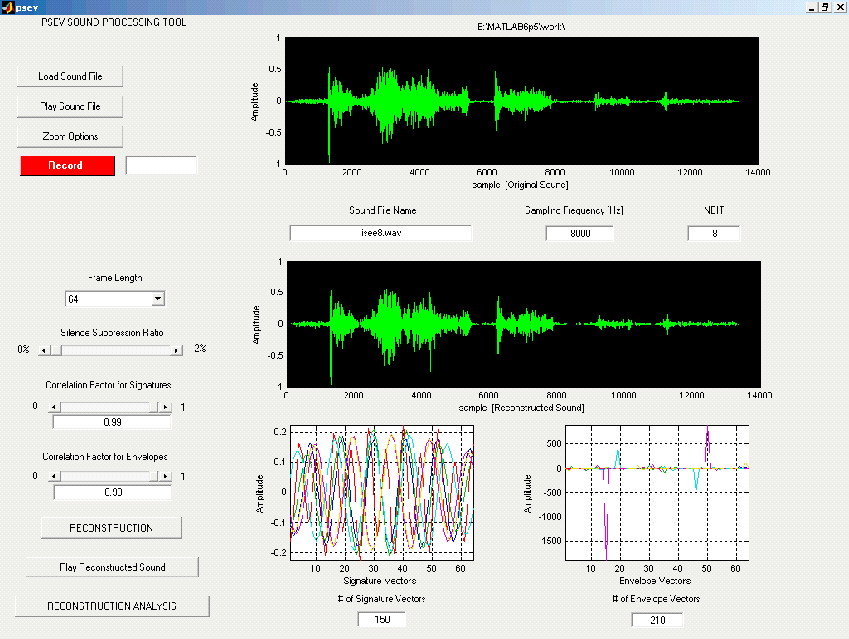
Fig. 1: Screen Image of the developed Graphical User Interface (GUI)
1.
The new method is not only used in compression and coding but also can be used
in order to obtain speech characteristics for any person: The PSEFB is generated
after a lot of investigations, analysis and tests on the patterns of speech
signals. As a result, it is observed that there are several signature and
envelope feature vectors, which are also called building blocks of speech
signals constitute the PSEFB. These building blocks are used for compression or
coding of any speech signal and also can be used for the recognition of the
speakers.
2.
Complexity, reconstruction speed, memory requirements and compression rate are
highly developed thanks to PSEFB: Since the size of the PSEFB is adjustable
depending on the hearing quality the algorithms provide faster reconstruction,
less memory requirements and higher compression rates.
3.
The new approach predicts future directions in speech information processing
technologies, including speech recognition, synthesis and coding: The studies
going on is focused on integrating the systems, which are controlled and
processed by human and the machines. Although there is a lot of different
techniques have improved so far it is not possible to say these systems are
reliable completely. The proposed method can also be applied both the human
speech and physical systems (ECG, EEG signals etc.) and a robust and more
reliable system can be developed in order to recognize the persons.
4. The new method could be a useful way of explaining the universal characteristics of human vowel system.
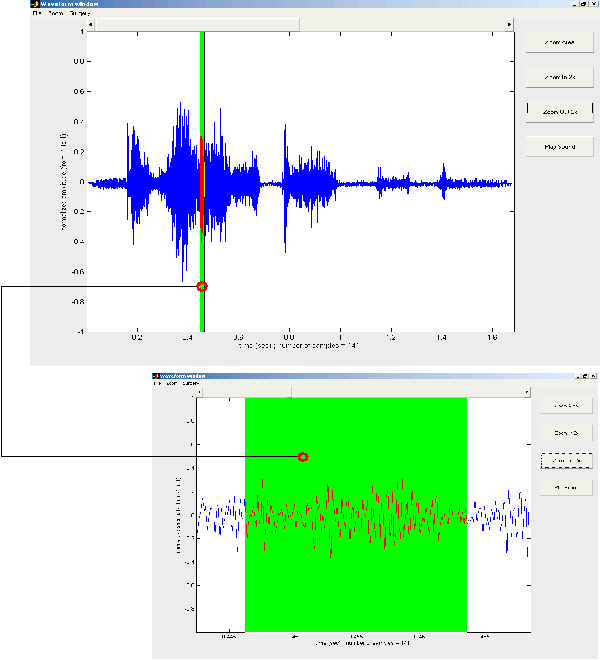
Fig. 2: Sub GUIs
2. Area of Biomedical SignalProcessing and Applications
Biological
signals, like the Electrocardiogram (ECG) and Electroencephologram (EEG), are
widespread in long time data storage, ambulatory recording systems, transmission
over the GSM or telecommunication systems, diagnosis and therapy of many
diseases. However, since such signals comprise huge amounts of data, the storage,
transfer and reconstruction of biological signals create certain limitations.
One way to overcome this problem is the compression of the signals, provided
that the information covered by the signal is not lost. Moreover, such signals
have to be repeatedly received and evaluated during the course of the illness in
order to verify the diagnosis, determine the treatment methods and allow follow
up of the therapy to avoid abnormal patterns and complications. Therefore,
compression of signals with acceptable loss is inevitable. Especially,
compression of the ECG and EEG signals are necessary so that the clinical
features preserved in the reconstructed signal.
Diagnosis, compression and speedy transmission of the ECG and EEG signals
may be achieved by means of appropriate models with least number of parameters.
In this case, the measured ECG and EEG data may be described in terms of the
parameters of the selected model. The objective of this work is to proposed a
novel method which enable very efficient compression and representation of the
ECG and EEG signals.
In our research work, on a frame basis, any EEG or ECG signal Xi(t) is modeled by the form of Xi(t) » Ci ai(t) ji(t). In this model, ji(t) is defined as the Predefined Signature Function (PSF) since it carries almost maximum energy of the frame vector Xi with a constant Ci. ai(t) is referred to as Predefined Envelope Function (PEF) since it matches the envelope of Ciji(t) to the original frame vector Xi; and Ci is called the Frame-Scaling Coefficient (FSC). It has been demonstrated that the sets F={jk(t)} and A={ar(t)} constitute a "Predefined Functional Bases or Banks (PFB)" to describe any measured ECG or EEG signal. In our research works, many ECG and EEG signals were examined and thousands of frames were analyzed. It has been observed that signature and envelope vectors exhibit repetitive similarities. Therefore, similar patterns can be eliminated by using the new algorithm; and we can create two types of banks; namely, " Predefined Envelope Bank (PEB) {ane(n); ne=1,2,…,NE}." and "Predefined Signature Bank (PSB) {jns(n); ns=1,2,…,NS}" respectively with reduced envelope and signature sequences. By evaluating the algorithm in the new method, for any given frame "i", the frame sequence Xi can be approximated by pulling an appropriate signature vector and envelope vector from PSB and PEB with a constant ci, in the LMS sense respectively. Finally, any EEG or ECG signal frame Xi can be represented in terms of the multiplication of envelope ai(t) and signature ji(t) functions with a constant Ci or Xi(t) = Cai eK(t) ji(t).
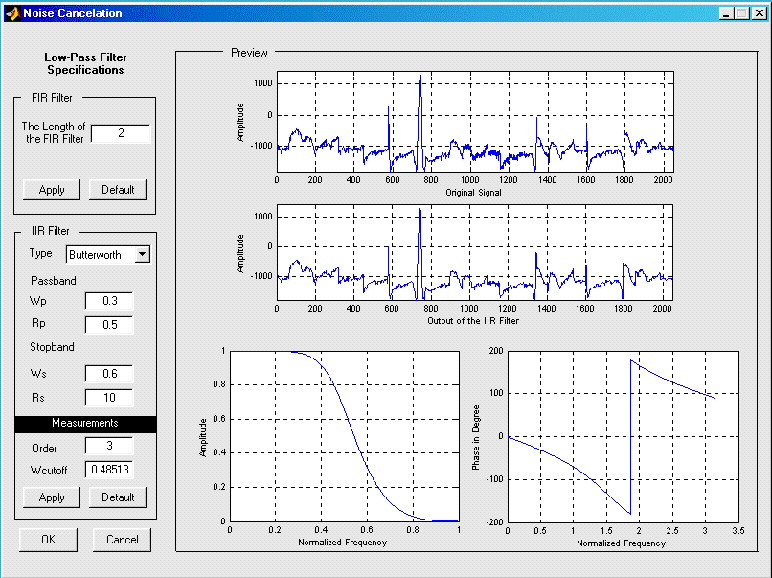
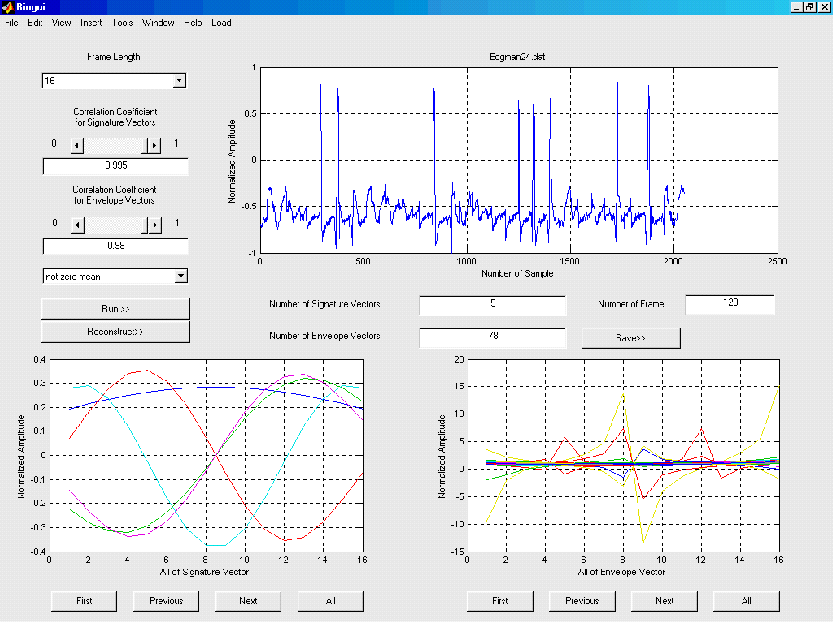
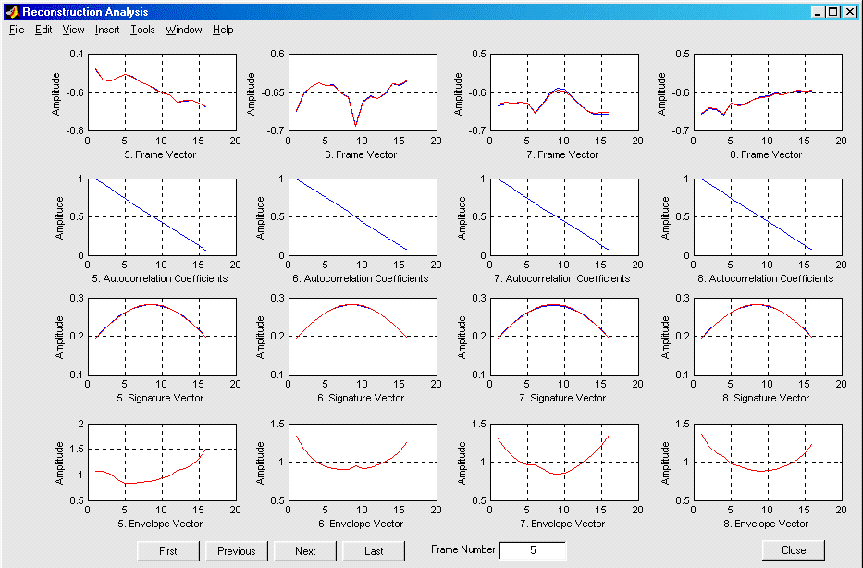
Figure 3, 4 & 5: Several screen images of the developed graphical user interface
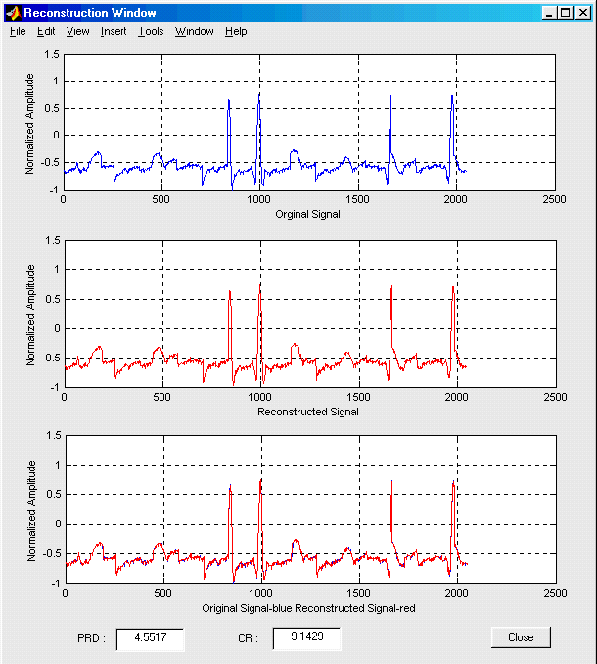
Figure 6: Screen image illustrating the original and reconstructed ECG signals with the value of Percent Root Mean Difference Error ( PRD) and the value of Compression Ratio (CR).
In the proposed method, each frame of any EEG or ECG signal is described by means of Ci (FSC) and two frame indexes "K" and "R" of PFB. The new method which is based on the generation of the PFB provides significant data compression while preserving the diagnostic information in the reconstructed signal. Furthermore, a computer program was designed that incorporate the new compression and modeling technique in user-friendly software which enable the user to easily compress and reconstruct biological (especially ECG and EEG) signal through a simple graphic interface. This interface allows the user to
·
Determine the Signature Functions of the Biological Signal
·
Determine the Envelope Functions of the Biological Signal
·
Compress the Biological Signals with High Compression
Ratio
·
Reconstruct the Compressed Biological Signals with Very
Low PRD Values.
·
Noise Cancellation
·
Baseline Removing
without knowledge of the mathematical details of the new modeling technique. This method can be used more efficient data storage and identification and/or classification of disorders by means of signature and envelope functions.
In our future research works, the signature functions and envelope
functions of the electrocardiogram signal that are recorded from patients by
using portable holter device will be determined.
After this process, obtained signature and envelope functions will be
stored in the Predefined Functional Base and classified according to the heart
diseases. The index numbers of these functions can be transmitted over the GSM
networks to the hospital or cardiologist. This
system enables the cardiologists to monitor their patients inside or outside of
the hospital in a long time period.
Selected
International Publications
1. Umit Guz, B. Siddik Yarman, Hakan Gurkan, “A New Word Recognition Algorithm by Using Signature and Envelope Feature Spaces”, ECCTD’03 16th European Conference on Circuit Theory and Design, Vol. III, pp.161-164, 1-4 September 2003 Kraków, Poland.
2. B. Siddik Yarman, Hakan Gurkan, Umit Guz, Birep Aygun, “A New Modeling Method of the ECG Signals Based on the Use of an Optimized Predefined Functional Database” Acta Cardiologica, International Journal of Cardiology, Vol. 58 (3), pp: 59-61, June 2003.
3. Hakan Gurkan, Umit Guz, B. Siddik Yarman, “Modeling of EEG Signals by Using Predefined Functional Bases”, EMBEC’02 2nd European Medical and Biological Engineering Conference, Proceedings of the International Federation for Medical & Biological Engineering, pp. 440-441, December 4-8, 2002, Vienna, Austria.
4.
Umit Guz, B. Siddik Yarman, Hakan Gurkan, “A New Method to
Represent Speech Signals via Predefined Functional Bases”, Proceedings of
ECCTD’01 15th European Conference on Circuit Theory and Design,
Vol. II, pp. 5-8, August 28-31, 2001, Espoo, Finland.
5.
Yarman B. S.,
Aksen A., Kilinc A., “An Immitance Based Tool for Modelling Passive One-Port
Devices by Means of Darlington Equivalents.” International Journal of
Electronic and Communications (AEÜ) 55 No 6, pp. 443-451, December 2001.
6.
B. Siddik Yarman, Ahmet
Aksen, Ebru Gursu Çimen, “Design And Simulation of Miniaturized Communication
Systems Employing Symmetrical Lossless Two-ports Constructed With Two Kinds of
Elements”, ISCAS2003,
IEEE
International Symposium on Circuits and Systems, May 25- 28, 2003, Bangkok,
Thailand.
7.
Padmala S. and Demir S.
S., “A
Computational Model of the Ventricular Action Potential in Adult Spontaneously
Hypertensive Rats”,
Journal of Cardiovascular Electrophysiology, Vol. 14, pp. 1-6, 2003.
8. Pandit S. V., Giles W. R. and Demir S. S., A Mathematical Model of Electrophysiological Alterations in Rat Ventricular Myocytes in Type-I Diabetes”, Biophysical Journal, Vol. 84 (2), pp. 832-841, 2003.
9.
Demir S.
S., “Computational Modeling Studies in Sinoatrial Node
Cells”, Journal of Cardiovascular Electrophysiology”, Vol. 13,
pp. 813-815, 2002.